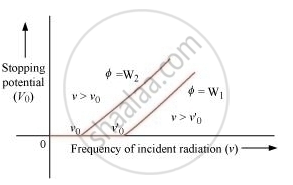Advertisements
Advertisements
प्रश्न
Plot a graph showing the variation of stopping potential with the frequency of incident radiation for two different photosensitive materials having work functions W1 and W2 (W1 > W2). On what factors does the (i) slope and (ii) intercept of the lines depend?
उत्तर

(i) The slope of the graph is content and equals to`(h/e)`. Therefore, the slope does not depend on any factor.
(ii) The intercept of the lines depends on the work function ‘’`phi` of the metals.
APPEARS IN
संबंधित प्रश्न
A negligibly small current is passed through a wire of length 15 m and uniform cross-section 6.0 × 10−7 m2, and its resistance is measured to be 5.0 Ω. What is the resistivity of the material at the temperature of the experiment?
Two resistors A and B have resistances RA and RB, respectively, and RA < RB. The resistivities of their materials are ρA and ρB.
A wire of length 1 m and radius 0.1 mm has a resistance of 100 Ω. Find the resistivity of the material.
What length of a copper wire of cross-sectional area 0.01 mm2 will be needed to prepare a resistance of 1 kΩ? Resistivity of copper = 1.7 × 10–8 Ωm
If R1 and R2 are filament resistances of a 200 W and a 100 W bulb respectively, designed to operate on the same voltage, then:
Choose the correct alternative:
The resistivity of the alloy manganin is nearly independent of/increases rapidly with increase of temperature.
Choose the correct alternative:
The resistivity of a typical insulator (e.g., amber) is greater than that of a metal by a factor of the order of (1022/1023).
Fuse wire should have
If the last band on the carbon resistor is absent, then the tolerance is ______
